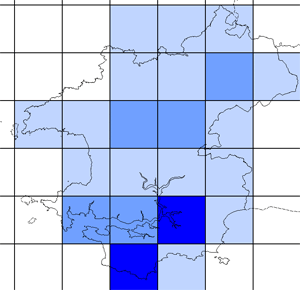Breeding resident and passage migrant
Although Mathew (1894) regarded the Goldcrest as a common resident, Lockley et al. (1949) remarked that they were not numerous in Pembrokeshire owing to a lack of conifers. Today they breed widely in small numbers over most of the county, but are extremely numerous in the conifer plantations that now exist. At an estimated density of ten pairs per tetrad, with possibly 500 pairs per tetrad in the plantations, the breeding population was probably about 5,000 pairs at the time of the Breeding Birds Survey of 1984-1988. Severe winters cause high mortality in Goldcrests, greatly reducing the breeding population.
A distinct, but erratic, spring passage occurs during the period 10 March to 27 May, when many small falls of 20 or so are found on headlands and the offshore islands.
They are normally more numerous on autumn passage, from 4 August to 12 November, and falls are generally larger; for example, about 250 were noted at Skomer on 8 October 1959.
Goldcrests are widespread in Pembrokeshire in the winter, joining mixed tit flocks and sometimes roving in loose-knit groups of their own species.

Fieldwork 1984-88 (based on 478 tetrads)
Red = breeding confirmed = 72
Orange = breeding probable = 139
Yellow = breeding possible = 38
Total tetrads in which registered = 249 (52.1%)
Donovan J.W. & Rees G.H (1994), Birds of Pembrokeshire
 Wednesday, August 7, 2013 at 7:53AM
Wednesday, August 7, 2013 at 7:53AM 





